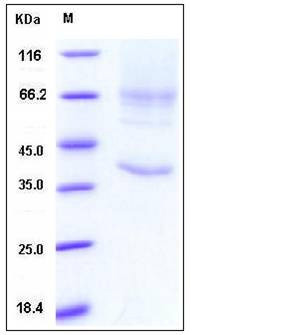Human Glypican 3 / GPC3 / OCI-5 Protein (His Tag)
DGSX,Glypican 3,GTR2-2,MXR7,OCI-5,SDYS,SGB,SGBS,SGBS1
- 100ug (NPP3895) Please inquiry
| Catalog Number | P10088-H08H |
|---|---|
| Organism Species | Human |
| Host | Human Cells |
| Synonyms | DGSX,Glypican 3,GTR2-2,MXR7,OCI-5,SDYS,SGB,SGBS,SGBS1 |
| Molecular Weight | The secreted recombinant human GPC3 comprises 546 amino acids and has a predicted molecular mass of 62 kDa. |
| predicted N | Gln 25 & Ser 359 |
| SDS-PAGE |  |
| Purity | > 87 % as determined by SDS-PAGE |
| Protein Construction | A DNA sequence encoding the human GPC3 (P51654-1) (Met 1-His 559) was expressed, with a C-terminal polyhistidine tag. |
| Bio-activity | Measured by its binding ability in a functional ELISA . Immobilized human GPC3 at 5 μg/ml (100 μl/well) can bind human bFGF / FGF2 with a linear ranger of 0.156-2.5 ng/ml. |
| Research Area | Cancer |Invasion microenvironment |Angiogenesis |Growth Factor & Receptor |Hedgehog |
| Formulation | Lyophilized from sterile PBS, pH 7.4 1. Normally 5 % - 8 % trehalose, mannitol and 0.01% Tween80 are added as protectants before lyophilization. Specific concentrations are included in the hardcopy of COA. |
| Background | Glypican-3, also known as Intestinal protein OCI-5, GPC3, and OCI5, is a member of the glypican family. It belongs to the glypican family and is highly expressed in lung, liver, and kidney. It is a heparan sulfate proteoglycan, which is overexpressed in various neoplasms such as hepatocellular carcinoma, malignant melanoma, and testicular yolk sac tumor, and plays an important role in cell growth and differentiation. GPC3 function is tissue dependent. In some tissues, GPC3 acts as a tumor suppressor gene, whereas in others, it acts as an oncofetal protein. Studies have shown that GPC3 is a reliable marker for hepatocellular carcinoma. The sensitivity and specificity exceeds both alpha-fetoprotein and hepatocyte-paraffin1. GPC3 immunohistochemistry can aid in the differentiation of testicular germ cell tumors, being expressed in all yolk sac tumors but not in seminomas. GPC3 expression has also been identified in some squamous cell carcinomas of the lung and clear cell carcinomas of the ovary. The role of GPC3 in melanomas is still controversial. Thus, Glypican-3 is currently regarded as a tumor marker and potential target for immunotherapy. |
| Reference |
